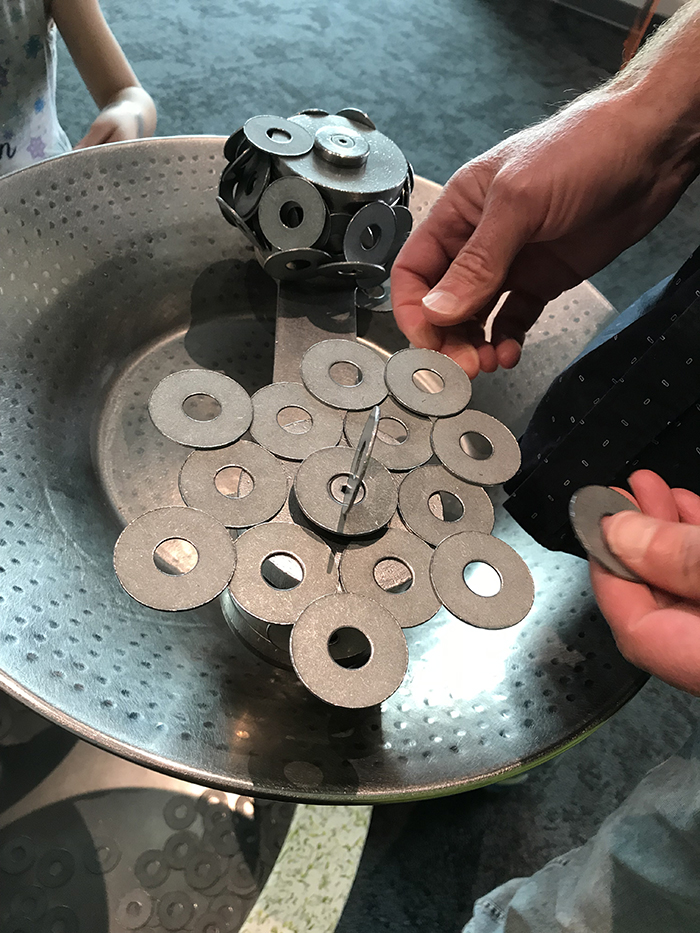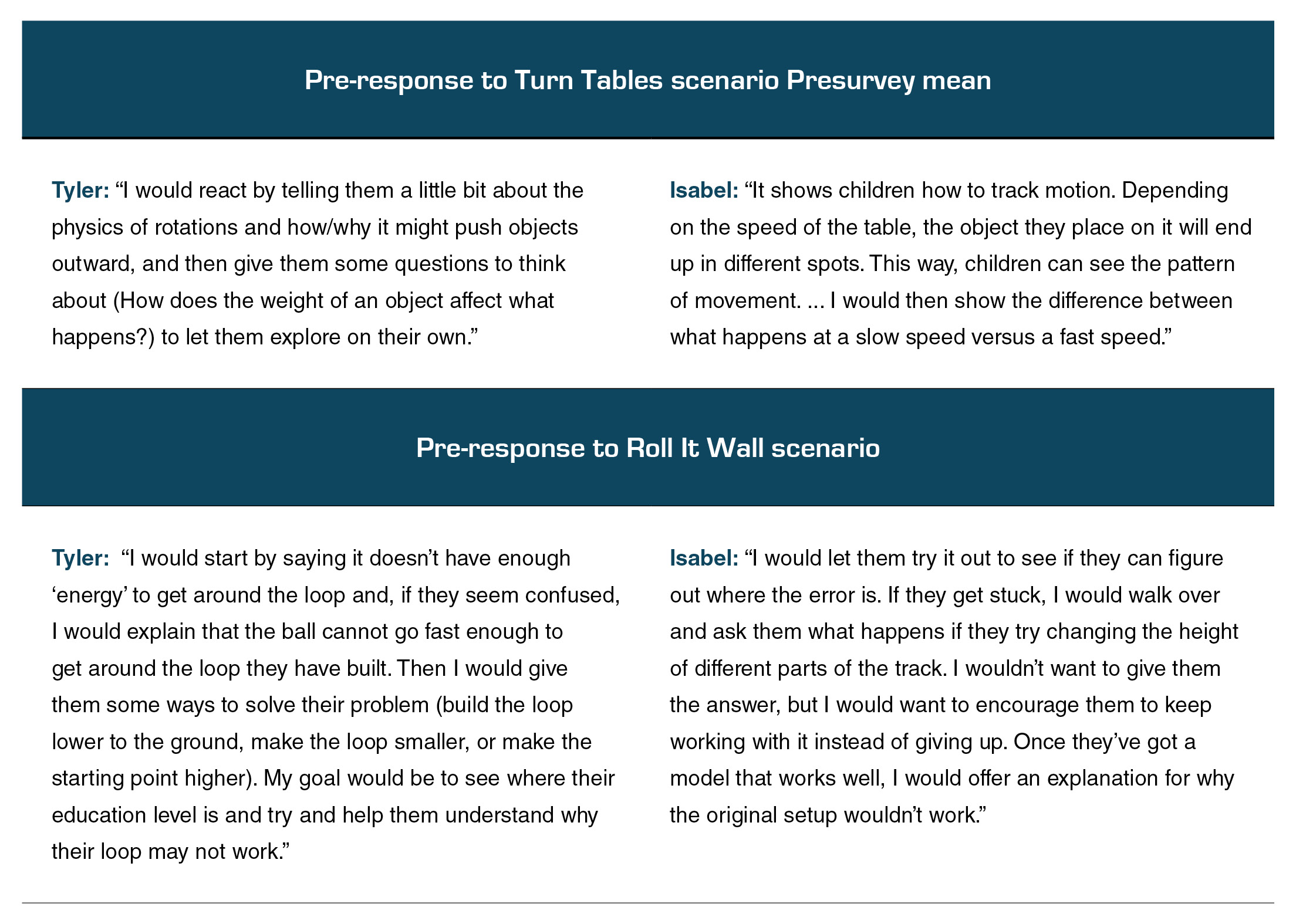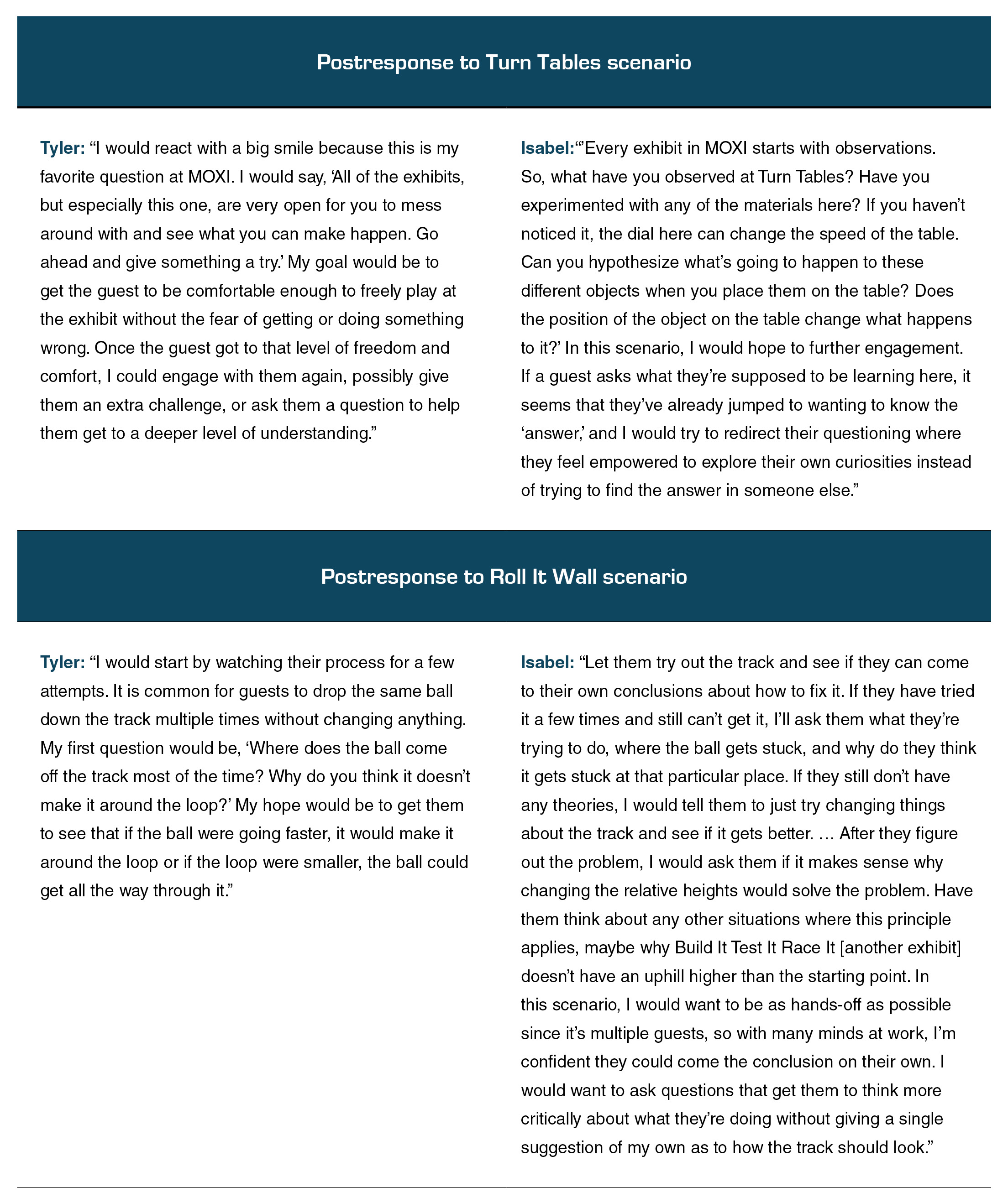Feature
Changing Mindsets Through Educator Training
Connected Science Learning October-December 2019 (Volume 1, Issue 12)
By Ron Skinner, Danielle B. Harlow, and Kaia Joye Wesolowski
MOXI, The Wolf Museum of Exploration + Innovation, is a new museum in Santa Barbara, California, designed to engage visitors of all ages in constructing understanding of STEM (science, technology, engineering, and math) topics through active engagement in the processes and practices of STEM. MOXI’s exhibits were informed by the Next Generation Science Standards (NGSS Lead States 2013) and by the the strands of informal science learning identified by the National Research Council’s publication Surrounded by Science (Bell et al. 2009; NRC 2010), which include engaging in scientific reasoning and using the tools and language of science. The NGSS focus as much on how science and engineering are done (the practices of science and engineering) as on the products of science and engineering. Specifically, MOXI’s exhibits were designed to allow for multiple modes of interaction and to have multiple entry points, allowing for productive, open-ended experiences for a wide range of learners.
Another aspect of the exhibit design at MOXI is intentionally minimal directional or explanatory signage. For example, one exhibit, Magnetic Islands (Figure 1), contains three very powerful magnets and a bowl of washers, which visitors use to build bridges between the magnets, create towers and chains of washers, and play washer-tossing games. This exhibit is similar to magnetic exhibits found in many science museums. At MOXI, Magnetic Islands is not accompanied by an explanation of magnetic properties. Nor are there specific instructions about what to do with the magnets and washers. The only sign reads, “Strong Magnet/Potente Iman.”
Visitors to MOXI sometimes ask floor staff, “What am I supposed to do here?” or “What am I supposed to learn?” These questions reveal a mindset about STEM learning and assumptions about science museums that we are attempting to disrupt.
A museum mindset
Science museums have traditionally been spaces where visitors observe objects and read text panels about their significance, or interact with videos and other media. When a visitor asks what they are supposed to do or learn at an exhibit, it implies that they believe there is one “right” way to interact with an exhibit or that there is one learning goal—and that the museum is the authority in both those areas. However, because MOXI’s exhibits provide multiple entry points and allow for a range of learning goals, a grandfather and his kindergarten-age granddaughter might play together at Magnetic Islands and do and learn very different things. So, the answers to the questions, “What am I supposed to do here?” and “What am I supposed to learn?” depend on the visitor.
At MOXI, the learning goal is really for visitors to develop their ability to ask questions, make observations, and support their ideas with evidence. So, if we were able to answer the question, “What am I supposed to learn here?” an appropriate answer might be something similar to,
Our goal at Magnetic Islands is for you to make some intentional observations, learn to ask questions about the properties of magnets, experiment to test your questions, and develop an explanation of magnetism that you can support with evidence. The specific learning goal, however, depends on each individual visitor’s interests, abilities, prior knowledge, and experience. We hope that this experience, combined with others at MOXI, will contribute to a larger goal of developing your capacity and confidence to engage in science and empower you to think of yourself as someone capable of learning and doing science.
This response differs considerably from the response that visitors should learn that the strength of the magnetic field decreases as one moves farther away from the magnet, that magnets have two poles, or even that some materials are attracted to a magnet whereas some are not. Although the exhibit affords visitors the opportunity to learn these ideas, we do not expect any visitor to learn all of these things or even necessarily any of them. When scientists encounter a new phenomenon, it can take months or years before they develop a conceptual understanding. Why then would we expect a museum visitor, encountering a new phenomenon, to develop a conceptual understanding during the few minutes they are engaged with an exhibit?
Moving from the expected content-based learning goal to the less-directed goal focused on learning through exploration requires not only changing visitors’ mindsets about the role of a museum, but also changing their mindsets about science—from viewing science as a collection of facts and ideas to viewing science as a way of thinking and engaging that can be developed and practiced.
Drawing from formal and informal education to develop a model of learning
We call our model of learning practice-based learning, which is facilitated through practice-based facilitation (Harlow and Skinner 2019). Like MOXI’s exhibits, practice-based learning is informed by the NGSS (NGSS Lead States 2013), which describe a vision for K–12 schools where students learn science through engaging in the practices of science and engineering. We combined the eight NGSS practices (e.g., Asking Questions and Defining Problems, Developing and Using Models, and Carrying Out Investigations) with additional practices of science and engineering developed by others (e.g., Cunningham and Kelly 2017) and refer to them collectively as STEM practices. Learning through engaging in STEM practices requires new ways of thinking about exhibit guidance. Static questions on labels, even generic ones such as, “What do you notice?” are not interactive, and they do not push visitors to engage in different ways of thinking or exploring an exhibit. Such active engagement in thinking and exploring requires an educator who is familiar with the exhibit and able to ask the right question at the right time.
This type of facilitation is aligned with the idea of responsive teaching in classrooms (Hammer, Goldberg, and Fargason 2012). Regardless of the context, learners develop new ideas through the lens of their prior experiences (Driver et al. 1994). In formal classroom spaces, this means that science teachers should elicit students’ ideas through discussion or written activities and adjust their instruction in response to students’ ideas. In informal spaces, this process is complex, because visitors come from a broader range of ages and backgrounds than is typical in a single classroom, and opportunities to assess prior ideas is limited to observing or talking with visitors during brief interactions. Museum educators do not have much time to consider the visitor’s ideas and must decide immediately how to respond appropriately.
However, despite these challenges, museums also have affordances that simplify the task of anticipating visitors’ ideas. Because classrooms have the same children day after day, the learning goals and activities change over units and from day to day, or even moment to moment, to facilitate students’ continued learning. In contrast, museums do not have the same people day to day, but they do have the same exhibits each day, often over a period of years. Museum educators have the opportunity to observe visitors engaging with the same exhibits many times per day over long periods of time. Thus, they have the opportunity to observe and facilitate with different people doing the same (or similar) thing over and over again in quick succession. Even with open-ended exhibits that have multiple entry points and multiple learning outcomes, patterns emerge in the ways in which visitors engage with them.
Practice-based facilitation is the pedagogical strategy we developed to support learning in MOXI that aligns with our model of learning. For each exhibit, we first identify a handful of common ways that visitors engage with the exhibit. For example, one way that visitors engage with Magnetic Islands is to construct chains of washers, with the first washer connected to the base of the strong magnet. Each identified type of engagement is matched to the STEM practices that a hypothetical visitor would be using at that engagement level. The museum educator then can make facilitation decisions after just a few moments of observing a guest. Once the assessment is made, museum educators might ask a question or give a prompt designed to do one of three things: maximize engagement by helping the visitor interact with the exhibit in more complex ways, optimize a visitor’s use of a specific STEM practice by encouraging the visitor to increase the sophistication of a practice he or she is already using, or expand a visitor’s use of STEM practices by encouraging the visitor to employ a practice that he or she may not be using.
Our challenge was maintaining a low enough turnover rate in our entry-level floor staff to justify the cost of the training required to deliver effective practice-based facilitation. To address this challenge, we developed an educator training and certificate program to train floor staff to implement visitor experiences that are consistent with the goal of engaging visitors in STEM practices while providing them with professional development opportunities.
Collaborative development of the informal educator training and certificate program
MOXI and University of California, Santa Barbara (UCSB), collaborated to develop an informal educator training and certificate program. Each year, approximately 10 participants are selected through an application process to become a cohort of the training program. Most applicants have completed an undergraduate degree and are considering careers in informal education or K–12 teaching. They commit to a yearlong program and work part-time as MOXI informal educators (whom we call Sparks) while taking a series of courses through UCSB’s professional certificate program, which culminates in a certificate in informal STEM learning.
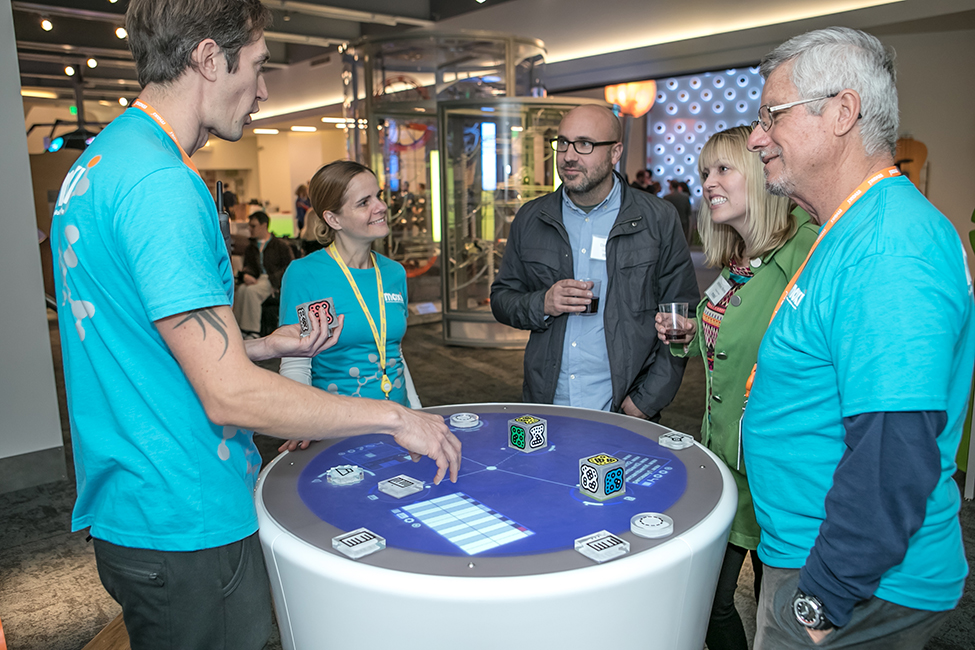
Image courtesy of MOXI
The program coursework draws from teacher education (formal education) and informal education to create a coherent program that results in visitor learning that complements the school-based learning of the children who visit MOXI and increases all visitors’ comfort and skill in learning through STEM practices. At the same time, because the collaboration includes faculty from UCSB’s teacher education program, the knowledge gained by education faculty through collaborating on developing the program for informal educators influences the teacher education program, resulting in classroom teachers learning to teach in ways that align with MOXI’s experience, providing mutually reinforcing experiences for school children. The alignment of the MOXI informal educator training program and UCSB’s teacher education program means that the training program also serves as a natural feeder to the UCSB teacher education program for those wanting to teach in a classroom environment. Each year, some graduates of MOXI’s informal educator training program have entered teacher education programs.
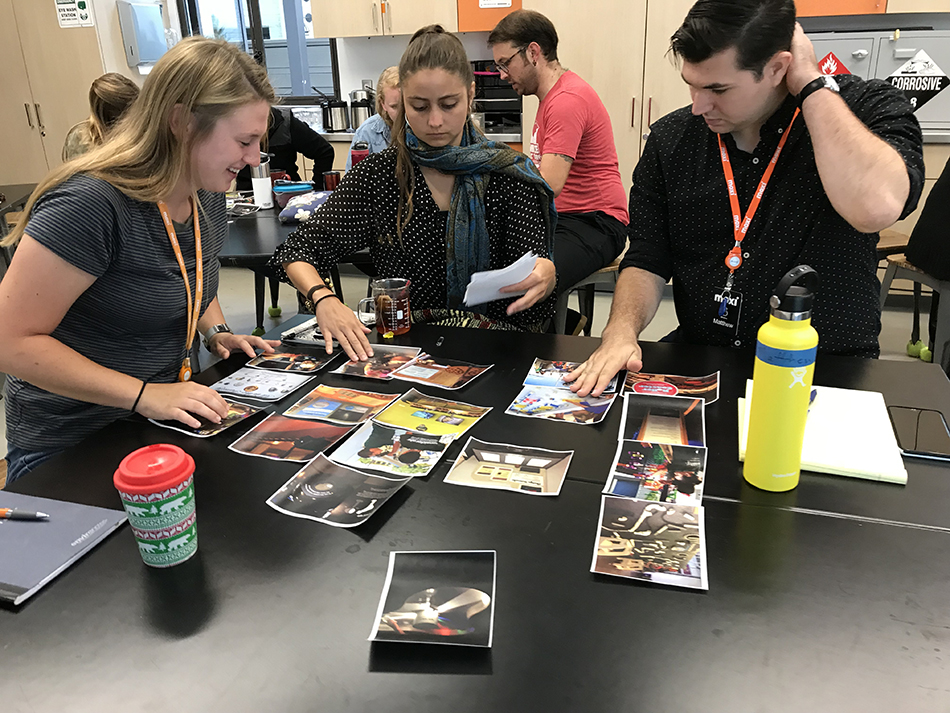
The coursework each quarter focuses on a different aspect of the responsibilities of informal educators, and the Sparks apply and reflect on new practices and strategies learned in their coursework while working directly with visitors on the floor at MOXI. Their interactions with visitors include facilitating experiences at exhibits, implementing STEM-based activities at program carts, working in MOXI’s makerspace, and leading field trip programs for school groups.
In the fall, the Sparks learn about our model of practice-based facilitation to support visitors in practice-based learning, and then focus on using practice-based facilitation when guiding visitors’ experience with exhibits and STEM-based activities at program carts. Sparks observe visitors at exhibits, characterize the types of engagements they observe, and identify potential facilitation moves that fit within our framework of maximizing engagement, optimizing a STEM practice the visitor is using, or expanding the visitor’s use of STEM practices.
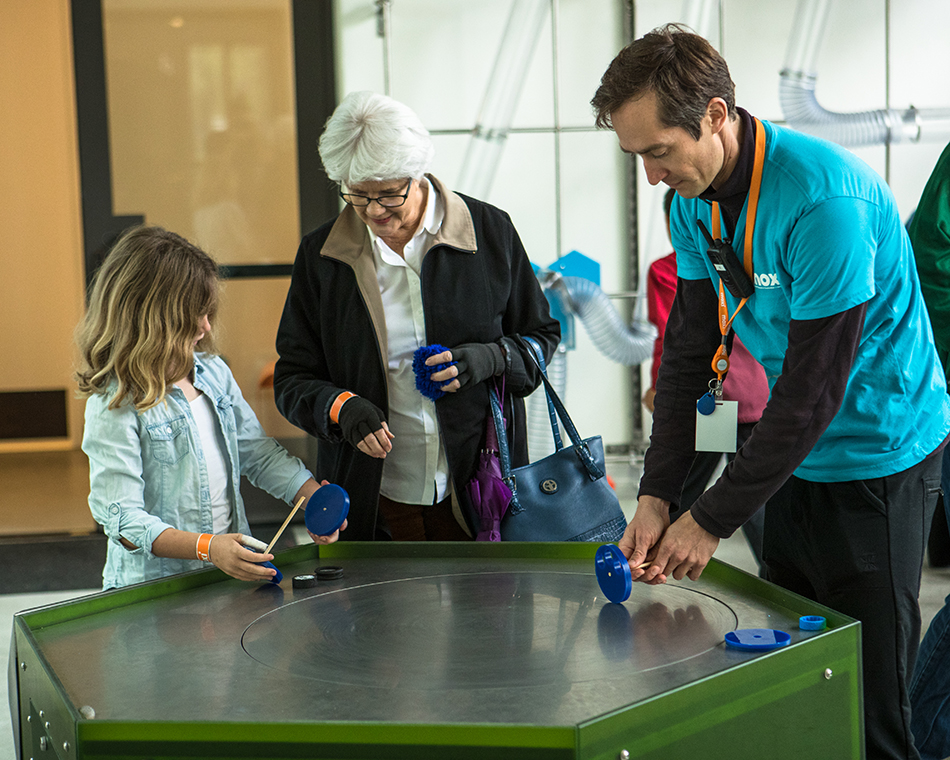
Image courtesy of MOXI
The winter quarter focuses on curriculum design, including accessibility and universal design for learning. The Sparks analyze existing curricula for school field trip programs and talk about learning goals and outcomes. They prototype and implement activities for MOXI’s field trip programs, focusing on engineering design (for more details see Connolly, Skinner, and Harlow, Forthcoming), and participate in associated outreach programs in elementary school classrooms. They also consider curricula for the many different types of learning activities in a museum, from makerspace activities to STEM-based program carts, to the most open-ended experiences at interactive exhibits. They then develop, test, and iterate on an activity of their own design. In 2018 we focused on STEM-based program cart activities, and in 2019 we focused on curricula for activities in the makerspace. In all cases, the Sparks consider how the curriculum guides the visitor to engage in STEM practices and include facilitation moves from the practice-based facilitation framework.
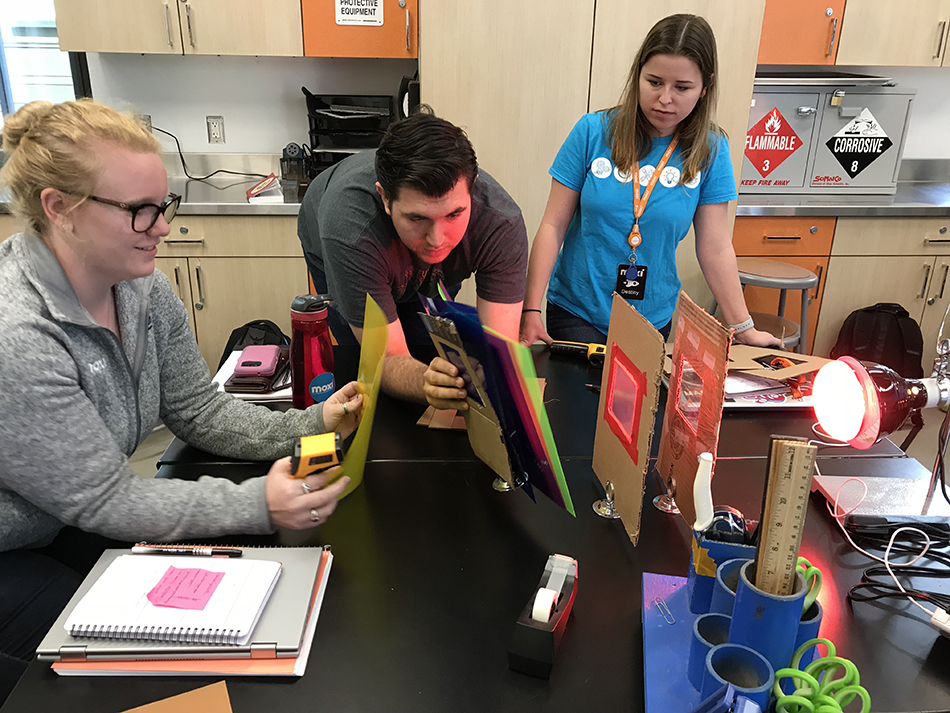
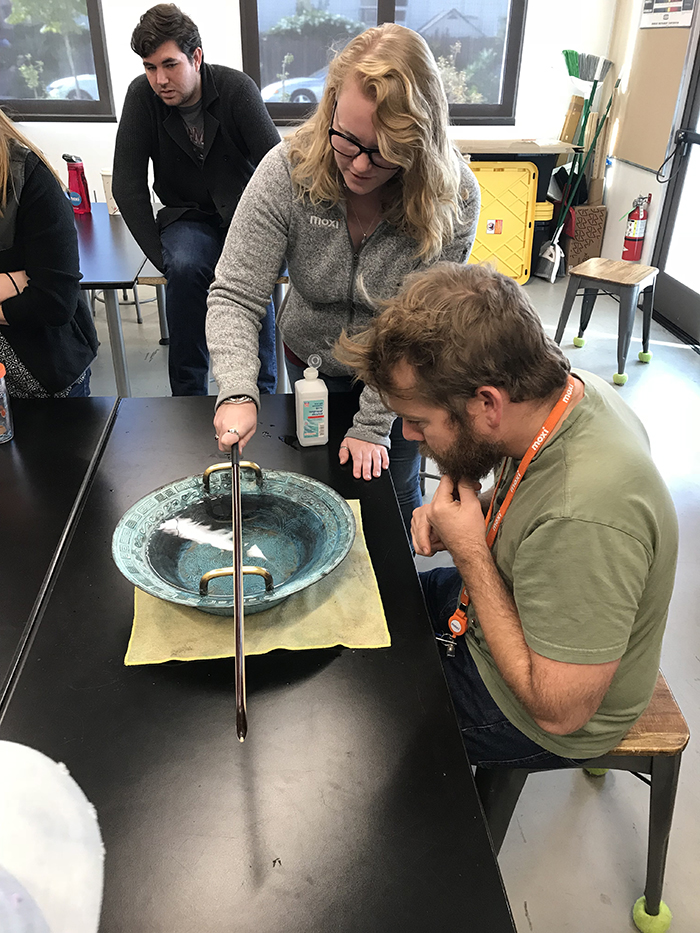
In the spring, the Sparks focus on research and evaluation. Their coursework introduces qualitative research methods such as observations, interviews, and open-ended surveys, as well as more quantitative methods, such as calculating dwell time and basic statistical analysis of quantitative survey data. They also consider the purposes of conducting evaluation, such as understanding visitor needs before creating a new program, assessing how well something is working to inform changes, and reporting to funding agencies. The Sparks then conduct an evaluation project through the lens of practice-based learning.
During the Sparks’ summer in the program, they complete a capstone project that builds on what they learned during the program and relates to their own professional goals. They also take on additional leadership roles through mentoring new Sparks who are beginning the program and training teen volunteers.
As part of the coursework each quarter, the Sparks read and reflect on research and practitioner articles related to the core focus. During their work on the floor, they have opportunities to practice daily what they have learned, shadow more experienced staff, and be mentored by MOXI’s full-time professional educators. Furthermore, the Sparks’ work provides opportunities to interact with classroom teachers who bring students to the museum. Across both the courses and work on the floor, the cohort model encourages peer learning and networking.
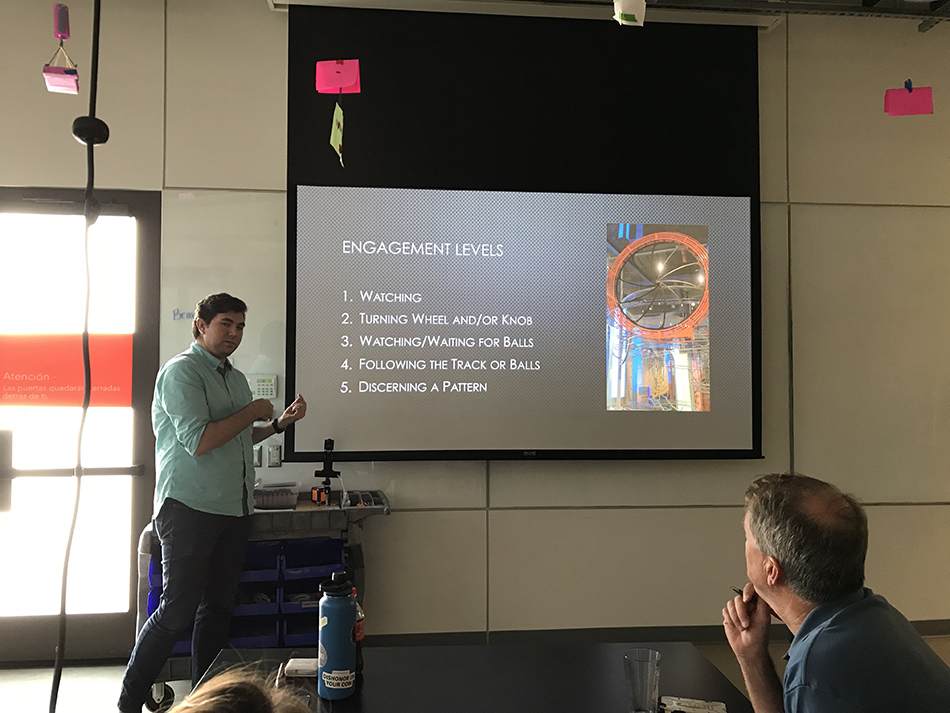
Evidence of success
Our second cohort of graduates completed the program this past summer. Throughout the two years of the program, we have collected a variety of data to track the Sparks’ progress and ideas. They complete initial and final assessments, write reflective blog posts about their observations and experiences working with guests, and complete classwork including developing curricula, facilitation guides, and a research study, using our learning framework to look closely at visitors’ experiences at one specific exhibit. In addition, we observe the Sparks in action as they facilitate learning at MOXI. As an indicator of success, we have direct evidence that the Sparks change their ways of facilitating and thinking about engaging visitors over the course of the educator training and certificate program.
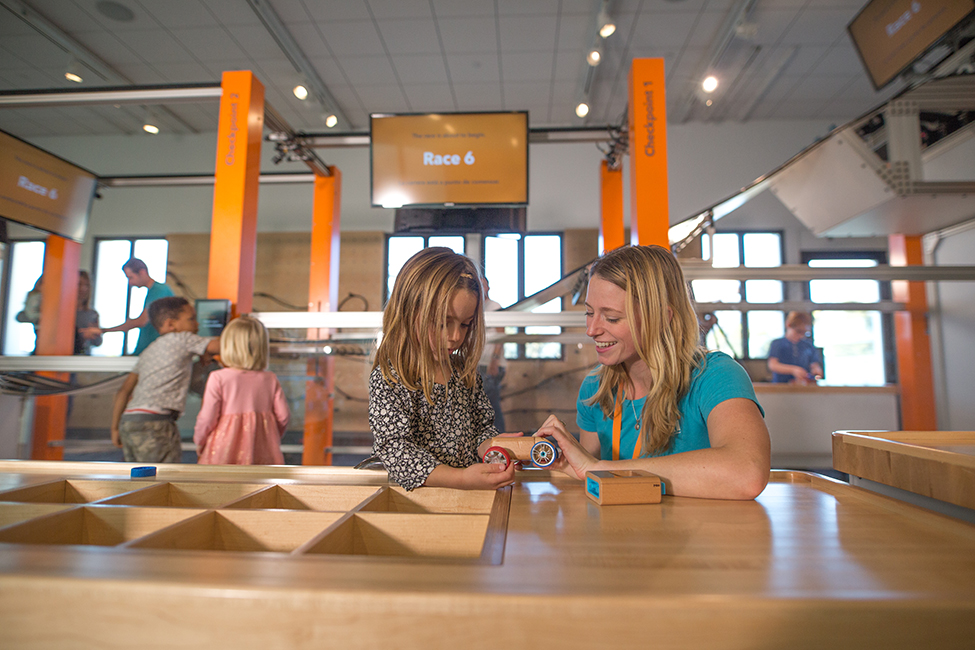
Image courtesy of MOXI
Tyler and Isabel (pseudonyms) are two Sparks who completed the program in year 1. Tyler entered the training program with the career goal of becoming a high school teacher and Isabel intended to pursue a career in informal science education. Both Sparks had prior experience working with children, and Isabel had spent considerable time working in children’s museums. The initial assessment was given at the beginning of the coursework, which started two weeks after the Sparks began working at MOXI and after they had finished the “on-boarding” training provided to all new floor staff. Thus, they had been introduced to MOXI’s philosophy of engaging visitors in exploration and were familiar with the exhibits.
The assessment included scenarios that happen often at MOXI and asked how they would respond (what they would say and do) and what the goal for the interaction would be. The scenarios were designed to elicit the Sparks’ ideas about how to best facilitate exhibits covering a range of physics topics and respond to visitors across a range of ages and abilities. To illustrate how the Sparks’ ideas developed, we present responses (Tables 1 and 2) from two scenarios:
Turn Tables: “An adult visitor approaches you at the Turn Tables (spinning tables that you can place objects on) and says, ‘So, what am I supposed to be learning here?’”
Roll It Wall: “A group of children (ages 10–12) at Roll It Wall is attempting to build a track that allows a ball to roll around a loop and land in a bucket. You can tell that they have built too big of a loop. The top of the loop is higher than the place they start the ball.”
Table 1
Initial responses to scenarios (September 2017)
Both Isabel and Tyler, in their initial responses (Table 1), indicate that they would engage visitors in learning through exploration. However, they both begin by “telling.” Tyler explains the physics (“tell them a little bit about the physics of rotations”; “start by saying it doesn’t have enough energy to get around the loop … and explain that the ball cannot go fast enough”), and Isabel explains the goal of the exhibits and gives explicit instructions on what to do (“show them the difference between what happens at slow speed verses a fast speed”; “ask them what happens if they try changing the height of different parts of the track”). In contrast, at the end of the program, both Sparks describe facilitation moves that guide visitors toward engaging in practices of science (Table 2). For the Roll It Wall scenario, both Isabel and Tyler describe beginning by observing the visitor’s process, rather than jumping in with an immediate explanation or suggestion. They then offer questions to guide thinking and to encourage visitors to engage in the practices of science.
Table 2
Final responses to scenarios (August 2018)
Next steps
Our next steps are to conduct systematic research on the program to refine the facilitation strategies, and then develop training modules that will be distributed for testing in other museums. Feedback from these other institutions will inform recommendations for broader use of the training modules.
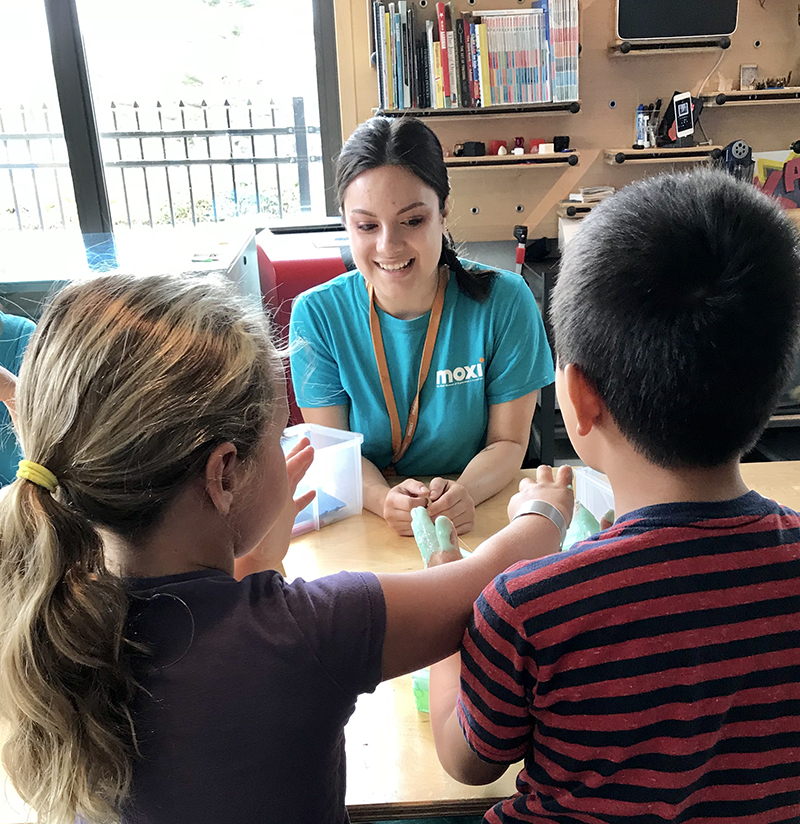
Conclusion
We have evidence that our Sparks are changing their mindsets about STEM learning. Like many informal educators, most of our Sparks begin the program with a strong initial instinct to instruct and explain, whether that be the physics content of the exhibit or how to interact with an exhibit. And many of our adult visitors expect that, whether it be through the floor staff or exhibit labels, the museum will serve as the authority on science. As early as 1976, Frank Oppenheimer, the founder of the Exploratorium, noticed this same mindset and discussed the tension between “unfettered exploration” and “detailed guidance.” He described, “If we do not tell people what they are supposed to find, many will leave with a sense of frustration, but a few will have become addicted to finding more than anybody knew was there. Since there is no going back if one gives away too much, we tend to lean toward the more radical answer to this arguable question [to limit written labels]” (Oppenheimer 1976). At that time, the Exploratorium’s approach to the visitor experience was “radical,” but increasingly, museums are moving toward focusing on visitors’ experience rather than on content. Our goal at MOXI is to change visitors’ mindsets about museums and STEM. We start with our educators.
Acknowledgments
The materials and work described in the “Next Steps” section of this article will be supported in part by the National Science Foundation under Grant No. 1906320 and Grant No. 1906322.
Ron Skinner (Ron.Skinner@moxi.org) is the director of education at MOXI, The Wolf Museum of Exploration + Innovation, in Santa Barbara, California. Danielle B. Harlow (danielle.harlow@ucsb.edu) is professor of science education at the University of California, Santa Barbara in Santa Barbara, California. Kaia Joye Wesolowski (kj.Wesoloski@moxi.org) is the associate director of education at MOXI, The Wolf Museum of Exploration + Innovation, in Santa Barbara, California.
citation: Skinner, R., D.B. Harlow, and K.J. Wesolowski. 2019. Changing mindsets through educator training. Connected Science Learning 1 (12). https://www.nsta.org/connected-science-learning/connected-science-learning-october-december-2019/changing-mindsets
Interdisciplinary Professional Learning old Informal Education



